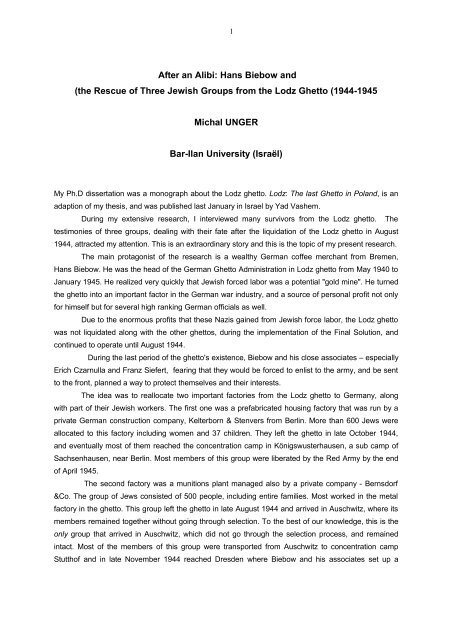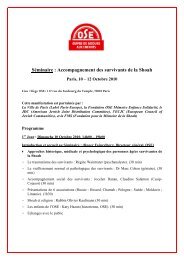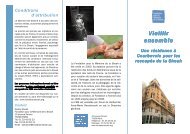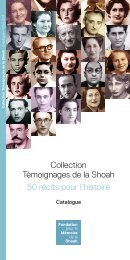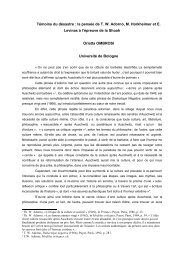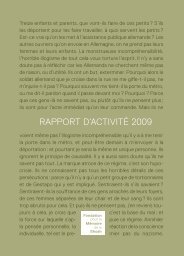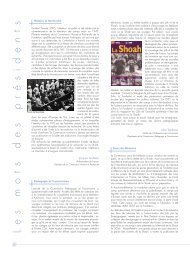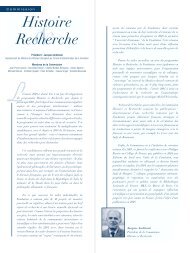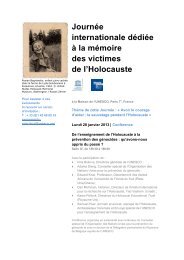After an Alibi: Hans Biebow and the Rescue of Three Jewish Groups ...
After an Alibi: Hans Biebow and the Rescue of Three Jewish Groups ...
After an Alibi: Hans Biebow and the Rescue of Three Jewish Groups ...
You also want an ePaper? Increase the reach of your titles
YUMPU automatically turns print PDFs into web optimized ePapers that Google loves.
<strong>After</strong> <strong>an</strong> <strong>Alibi</strong>: H<strong>an</strong>s <strong>Biebow</strong> <strong>an</strong>d<br />
( <strong>the</strong> <strong>Rescue</strong> <strong>of</strong> <strong>Three</strong> <strong>Jewish</strong> <strong>Groups</strong> from <strong>the</strong> Lodz Ghetto (1944-1945<br />
Michal UNGER<br />
Bar-Il<strong>an</strong> University (Israël)<br />
My Ph.D dissertation was a monograph about <strong>the</strong> Lodz ghetto. Lodz: The last Ghetto in Pol<strong>an</strong>d, is <strong>an</strong><br />
adaption <strong>of</strong> my <strong>the</strong>sis, <strong>an</strong>d was published last J<strong>an</strong>uary in Israel by Yad Vashem.<br />
During my extensive research, I interviewed m<strong>an</strong>y survivors from <strong>the</strong> Lodz ghetto. The<br />
testimonies <strong>of</strong> three groups, dealing with <strong>the</strong>ir fate after <strong>the</strong> liquidation <strong>of</strong> <strong>the</strong> Lodz ghetto in August<br />
1944, attracted my attention. This is <strong>an</strong> extraordinary story <strong>an</strong>d this is <strong>the</strong> topic <strong>of</strong> my present research.<br />
The main protagonist <strong>of</strong> <strong>the</strong> research is a wealthy Germ<strong>an</strong> c<strong>of</strong>fee merch<strong>an</strong>t from Bremen,<br />
H<strong>an</strong>s <strong>Biebow</strong>. He was <strong>the</strong> head <strong>of</strong> <strong>the</strong> Germ<strong>an</strong> Ghetto Administration in Lodz ghetto from May 1940 to<br />
J<strong>an</strong>uary 1945. He realized very quickly that <strong>Jewish</strong> forced labor was a potential "gold mine". He turned<br />
<strong>the</strong> ghetto into <strong>an</strong> import<strong>an</strong>t factor in <strong>the</strong> Germ<strong>an</strong> war industry, <strong>an</strong>d a source <strong>of</strong> personal pr<strong>of</strong>it not only<br />
for himself but for several high r<strong>an</strong>king Germ<strong>an</strong> <strong>of</strong>ficials as well.<br />
Due to <strong>the</strong> enormous pr<strong>of</strong>its that <strong>the</strong>se Nazis gained from <strong>Jewish</strong> force labor, <strong>the</strong> Lodz ghetto<br />
was not liquidated along with <strong>the</strong> o<strong>the</strong>r ghettos, during <strong>the</strong> implementation <strong>of</strong> <strong>the</strong> Final Solution, <strong>an</strong>d<br />
continued to operate until August 1944.<br />
During <strong>the</strong> last period <strong>of</strong> <strong>the</strong> ghetto's existence, <strong>Biebow</strong> <strong>an</strong>d his close associates – especially<br />
Erich Czarnulla <strong>an</strong>d Fr<strong>an</strong>z Siefert, fearing that <strong>the</strong>y would be forced to enlist to <strong>the</strong> army, <strong>an</strong>d be sent<br />
to <strong>the</strong> front, pl<strong>an</strong>ned a way to protect <strong>the</strong>mselves <strong>an</strong>d <strong>the</strong>ir interests.<br />
The idea was to reallocate two import<strong>an</strong>t factories from <strong>the</strong> Lodz ghetto to Germ<strong>an</strong>y, along<br />
with part <strong>of</strong> <strong>the</strong>ir <strong>Jewish</strong> workers. The first one was a prefabricated housing factory that was run by a<br />
private Germ<strong>an</strong> construction comp<strong>an</strong>y, Kelterborn & Stenvers from Berlin. More th<strong>an</strong> 600 Jews were<br />
allocated to this factory including women <strong>an</strong>d 37 children. They left <strong>the</strong> ghetto in late October 1944,<br />
<strong>an</strong>d eventually most <strong>of</strong> <strong>the</strong>m reached <strong>the</strong> concentration camp in Königswusterhausen, a sub camp <strong>of</strong><br />
Sachsenhausen, near Berlin. Most members <strong>of</strong> this group were liberated by <strong>the</strong> Red Army by <strong>the</strong> end<br />
<strong>of</strong> April 1945.<br />
The second factory was a munitions pl<strong>an</strong>t m<strong>an</strong>aged also by a private comp<strong>an</strong>y - Bernsdorf<br />
&Co. The group <strong>of</strong> Jews consisted <strong>of</strong> 500 people, including entire families. Most worked in <strong>the</strong> metal<br />
factory in <strong>the</strong> ghetto. This group left <strong>the</strong> ghetto in late August 1944 <strong>an</strong>d arrived in Auschwitz, where its<br />
members remained toge<strong>the</strong>r without going through selection. To <strong>the</strong> best <strong>of</strong> our knowledge, this is <strong>the</strong><br />
only group that arrived in Auschwitz, which did not go through <strong>the</strong> selection process, <strong>an</strong>d remained<br />
intact. Most <strong>of</strong> <strong>the</strong> members <strong>of</strong> this group were tr<strong>an</strong>sported from Auschwitz to concentration camp<br />
Stutth<strong>of</strong> <strong>an</strong>d in late November 1944 reached Dresden where <strong>Biebow</strong> <strong>an</strong>d his associates set up a<br />
1
munitions pl<strong>an</strong>t known as Bernsdorf & Co. Despite <strong>the</strong>ir suffering, mainly in Stutth<strong>of</strong>, most <strong>of</strong> its<br />
members survived <strong>an</strong>d were liberated in Theresienstadt in May 1945.<br />
These two big factories were connected to <strong>the</strong> Ministry <strong>of</strong> Armament headed by Albert Speer<br />
<strong>an</strong>d were recognized as essential to <strong>the</strong> war effort.<br />
There was a third group that remained in <strong>the</strong> ghetto after its liquidation to cle<strong>an</strong> <strong>the</strong> area <strong>an</strong>d<br />
pack up equipment that had been left behind, mainly in <strong>the</strong> factories. It consisted <strong>of</strong> approximately<br />
1,000 Jews. This group, like <strong>the</strong> o<strong>the</strong>r two, consisted <strong>of</strong> workers <strong>an</strong>d <strong>Jewish</strong> <strong>of</strong>ficials. These Jews were<br />
liberated by <strong>the</strong> incoming Soviet forces in J<strong>an</strong>uary 1945.<br />
We need to remember that this took place during <strong>the</strong> last period <strong>of</strong> <strong>the</strong> war – September 1944<br />
– April, May 1945. The Red Army had already liberated a large part <strong>of</strong> Pol<strong>an</strong>d <strong>an</strong>d was headed towards<br />
Germ<strong>an</strong>y. Germ<strong>an</strong> defeat was imminent. Chaos was everywhere. Most Germ<strong>an</strong> men were in <strong>the</strong> army<br />
<strong>an</strong>d <strong>the</strong>re was a severe shortage <strong>of</strong> m<strong>an</strong>power for <strong>the</strong> war industry. As a result <strong>the</strong> Germ<strong>an</strong>s used<br />
more th<strong>an</strong> seven million foreign force labor <strong>an</strong>d hundreds <strong>of</strong> thous<strong>an</strong>ds <strong>of</strong> prisoners from <strong>the</strong><br />
concentration camps, including Jews.<br />
These three groups that I am researching were part <strong>of</strong> this huge exploitation.<br />
In Conclusion - The purpose <strong>of</strong> this study is tw<strong>of</strong>old. At <strong>the</strong> specific level, it brings to light<br />
three groups <strong>of</strong> Jews, more <strong>the</strong>n 2,000 persons in all, in which most <strong>of</strong> <strong>the</strong>ir members survived, in spite<br />
<strong>of</strong> <strong>the</strong> Germ<strong>an</strong> policy in this last period to exterminate <strong>the</strong> remaining Jews in order not to leave <strong>an</strong>y<br />
evidence. What was signific<strong>an</strong>t about <strong>the</strong>se groups is how H<strong>an</strong>s <strong>Biebow</strong>, <strong>the</strong> main Nazi policymaker in<br />
regard to <strong>the</strong> Lodz ghetto, used <strong>the</strong>m for <strong>the</strong> continued implementation <strong>of</strong> his policy <strong>of</strong> using Jews <strong>an</strong>d<br />
<strong>Jewish</strong> forced labor for practical reasons. In <strong>the</strong> last stages <strong>of</strong> <strong>the</strong> war, he used <strong>the</strong>se three groups first<br />
<strong>of</strong> all to protect from being sent into combat at <strong>the</strong> front. The main reason however was to furnish<br />
himself <strong>an</strong>d his close associates with <strong>an</strong> alibi to avoid punishment for <strong>the</strong>ir war crimes. The paradox is<br />
evident: this Nazi war criminal, who participated in <strong>the</strong> <strong>an</strong>nihilation <strong>of</strong> <strong>the</strong> Jews <strong>of</strong> <strong>the</strong> Lodz ghetto <strong>an</strong>d<br />
o<strong>the</strong>r ghettos in <strong>the</strong> War<strong>the</strong>gau, rescued a large group <strong>of</strong> Jews as <strong>the</strong> war wound down. Even <strong>the</strong>n, he<br />
m<strong>an</strong>aged to persuade <strong>the</strong> SS to leave his groups intact. How could he have m<strong>an</strong>aged this? <strong>Biebow</strong>’s<br />
ability to remove <strong>the</strong> groups from Auschwitz <strong>an</strong>d Stuth<strong>of</strong>, shows how powerful his connections with <strong>the</strong><br />
SS must have been.<br />
The study explores also <strong>the</strong> problems <strong>an</strong>d difficulties that arose in <strong>the</strong> rescue <strong>of</strong> Jews <strong>an</strong>d<br />
shows how <strong>the</strong> fate <strong>of</strong> men, women, <strong>an</strong>d children depended on <strong>the</strong> personal interests <strong>an</strong>d initiatives <strong>of</strong><br />
a corrupt Germ<strong>an</strong> merch<strong>an</strong>t <strong>an</strong>d war criminal.<br />
The study has far-reaching implications. It is through this extraordinary episode that we may<br />
observe <strong>the</strong> last stage <strong>of</strong> <strong>the</strong> heightened tension that existed between <strong>the</strong> SS ideology <strong>of</strong> total<br />
<strong>an</strong>nihilation <strong>of</strong> <strong>the</strong> Jews, <strong>an</strong>d <strong>the</strong> more practical policy <strong>of</strong> exploiting <strong>the</strong> Jews for <strong>the</strong> benefit <strong>of</strong> <strong>the</strong> Reich<br />
<strong>an</strong>d for personal gain.<br />
2


